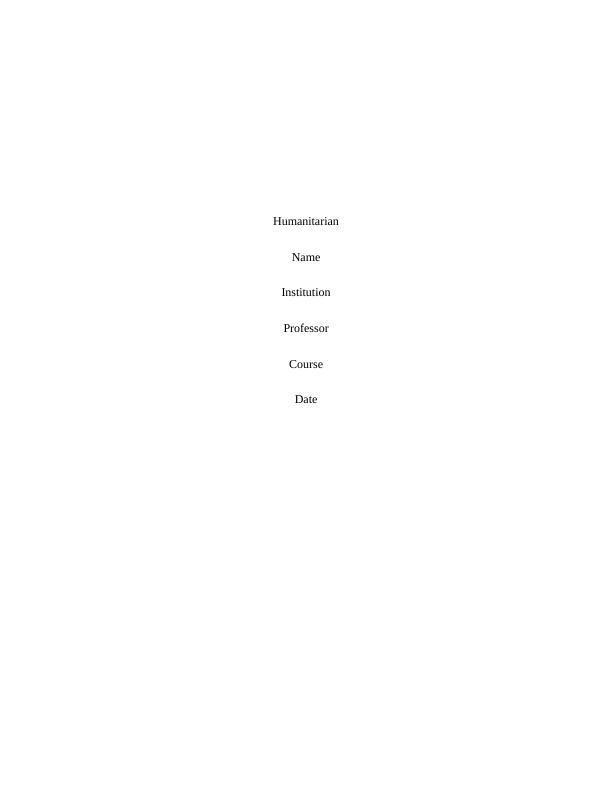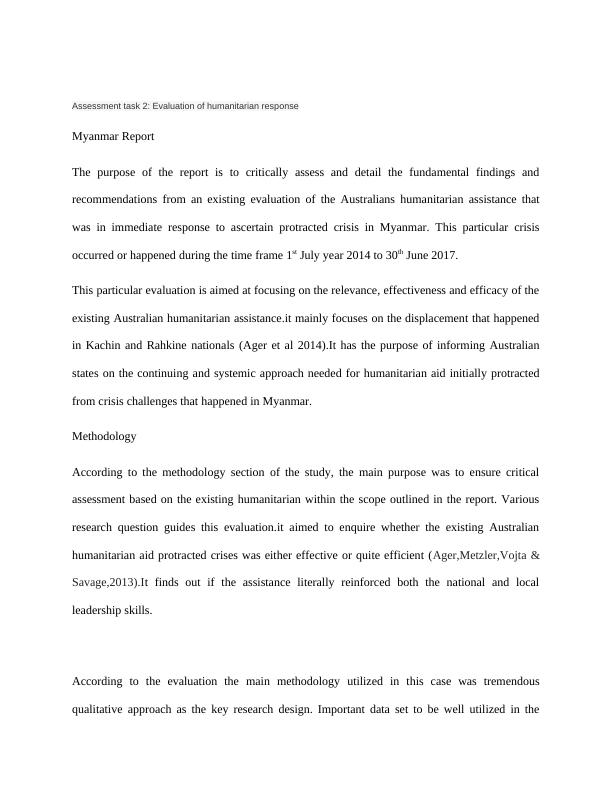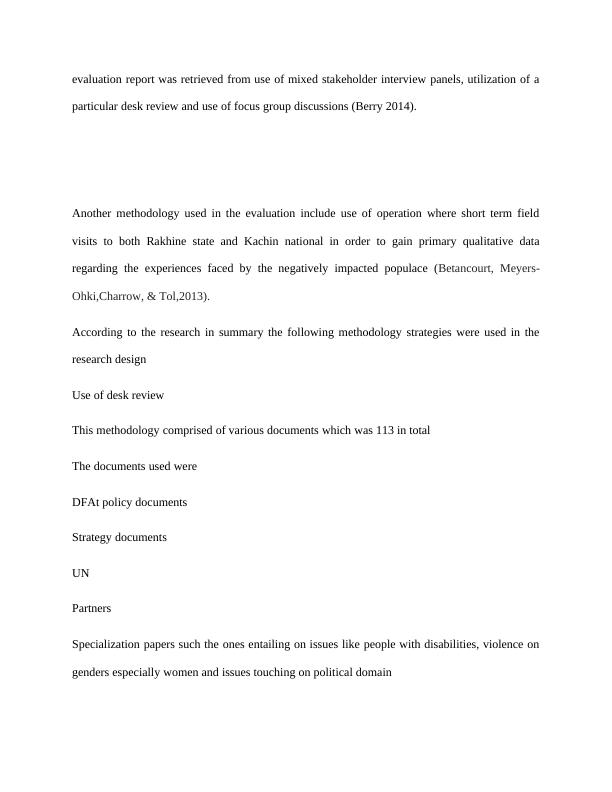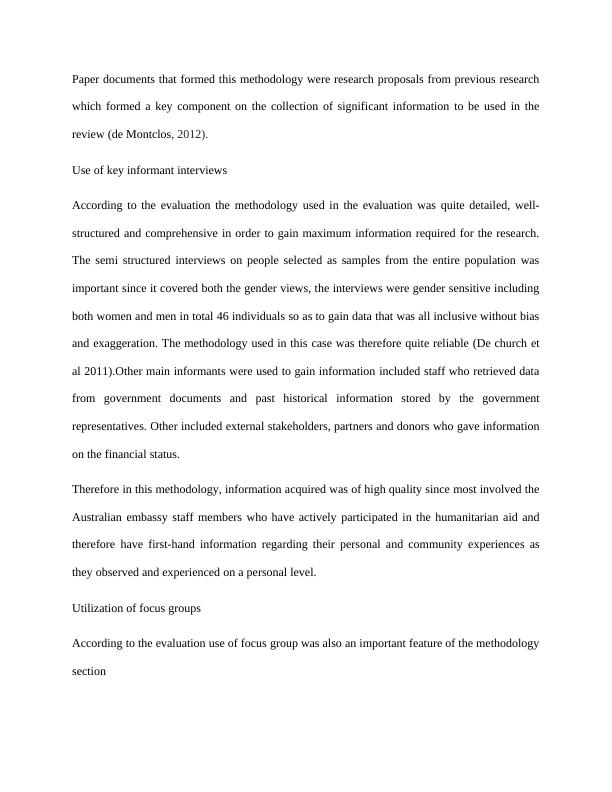Evaluation of Humanitarian Response in Myanmar
Added on 2023-01-03
18 Pages4476 Words76 Views
Humanitarian
Name
Institution
Professor
Course
Date
Name
Institution
Professor
Course
Date

Assessment task 2: Evaluation of humanitarian response
Myanmar Report
The purpose of the report is to critically assess and detail the fundamental findings and
recommendations from an existing evaluation of the Australians humanitarian assistance that
was in immediate response to ascertain protracted crisis in Myanmar. This particular crisis
occurred or happened during the time frame 1st July year 2014 to 30th June 2017.
This particular evaluation is aimed at focusing on the relevance, effectiveness and efficacy of the
existing Australian humanitarian assistance.it mainly focuses on the displacement that happened
in Kachin and Rahkine nationals (Ager et al 2014).It has the purpose of informing Australian
states on the continuing and systemic approach needed for humanitarian aid initially protracted
from crisis challenges that happened in Myanmar.
Methodology
According to the methodology section of the study, the main purpose was to ensure critical
assessment based on the existing humanitarian within the scope outlined in the report. Various
research question guides this evaluation.it aimed to enquire whether the existing Australian
humanitarian aid protracted crises was either effective or quite efficient (Ager,Metzler,Vojta &
Savage,2013).It finds out if the assistance literally reinforced both the national and local
leadership skills.
According to the evaluation the main methodology utilized in this case was tremendous
qualitative approach as the key research design. Important data set to be well utilized in the
Myanmar Report
The purpose of the report is to critically assess and detail the fundamental findings and
recommendations from an existing evaluation of the Australians humanitarian assistance that
was in immediate response to ascertain protracted crisis in Myanmar. This particular crisis
occurred or happened during the time frame 1st July year 2014 to 30th June 2017.
This particular evaluation is aimed at focusing on the relevance, effectiveness and efficacy of the
existing Australian humanitarian assistance.it mainly focuses on the displacement that happened
in Kachin and Rahkine nationals (Ager et al 2014).It has the purpose of informing Australian
states on the continuing and systemic approach needed for humanitarian aid initially protracted
from crisis challenges that happened in Myanmar.
Methodology
According to the methodology section of the study, the main purpose was to ensure critical
assessment based on the existing humanitarian within the scope outlined in the report. Various
research question guides this evaluation.it aimed to enquire whether the existing Australian
humanitarian aid protracted crises was either effective or quite efficient (Ager,Metzler,Vojta &
Savage,2013).It finds out if the assistance literally reinforced both the national and local
leadership skills.
According to the evaluation the main methodology utilized in this case was tremendous
qualitative approach as the key research design. Important data set to be well utilized in the

evaluation report was retrieved from use of mixed stakeholder interview panels, utilization of a
particular desk review and use of focus group discussions (Berry 2014).
Another methodology used in the evaluation include use of operation where short term field
visits to both Rakhine state and Kachin national in order to gain primary qualitative data
regarding the experiences faced by the negatively impacted populace (Betancourt, Meyers-
Ohki,Charrow, & Tol,2013).
According to the research in summary the following methodology strategies were used in the
research design
Use of desk review
This methodology comprised of various documents which was 113 in total
The documents used were
DFAt policy documents
Strategy documents
UN
Partners
Specialization papers such the ones entailing on issues like people with disabilities, violence on
genders especially women and issues touching on political domain
particular desk review and use of focus group discussions (Berry 2014).
Another methodology used in the evaluation include use of operation where short term field
visits to both Rakhine state and Kachin national in order to gain primary qualitative data
regarding the experiences faced by the negatively impacted populace (Betancourt, Meyers-
Ohki,Charrow, & Tol,2013).
According to the research in summary the following methodology strategies were used in the
research design
Use of desk review
This methodology comprised of various documents which was 113 in total
The documents used were
DFAt policy documents
Strategy documents
UN
Partners
Specialization papers such the ones entailing on issues like people with disabilities, violence on
genders especially women and issues touching on political domain

Paper documents that formed this methodology were research proposals from previous research
which formed a key component on the collection of significant information to be used in the
review (de Montclos, 2012).
Use of key informant interviews
According to the evaluation the methodology used in the evaluation was quite detailed, well-
structured and comprehensive in order to gain maximum information required for the research.
The semi structured interviews on people selected as samples from the entire population was
important since it covered both the gender views, the interviews were gender sensitive including
both women and men in total 46 individuals so as to gain data that was all inclusive without bias
and exaggeration. The methodology used in this case was therefore quite reliable (De church et
al 2011).Other main informants were used to gain information included staff who retrieved data
from government documents and past historical information stored by the government
representatives. Other included external stakeholders, partners and donors who gave information
on the financial status.
Therefore in this methodology, information acquired was of high quality since most involved the
Australian embassy staff members who have actively participated in the humanitarian aid and
therefore have first-hand information regarding their personal and community experiences as
they observed and experienced on a personal level.
Utilization of focus groups
According to the evaluation use of focus group was also an important feature of the methodology
section
which formed a key component on the collection of significant information to be used in the
review (de Montclos, 2012).
Use of key informant interviews
According to the evaluation the methodology used in the evaluation was quite detailed, well-
structured and comprehensive in order to gain maximum information required for the research.
The semi structured interviews on people selected as samples from the entire population was
important since it covered both the gender views, the interviews were gender sensitive including
both women and men in total 46 individuals so as to gain data that was all inclusive without bias
and exaggeration. The methodology used in this case was therefore quite reliable (De church et
al 2011).Other main informants were used to gain information included staff who retrieved data
from government documents and past historical information stored by the government
representatives. Other included external stakeholders, partners and donors who gave information
on the financial status.
Therefore in this methodology, information acquired was of high quality since most involved the
Australian embassy staff members who have actively participated in the humanitarian aid and
therefore have first-hand information regarding their personal and community experiences as
they observed and experienced on a personal level.
Utilization of focus groups
According to the evaluation use of focus group was also an important feature of the methodology
section

End of preview
Want to access all the pages? Upload your documents or become a member.
Related Documents
Evaluation of a new evidence-based approach to informative researchlg...
|12
|4064
|364
Critical Analysis of an Evaluation Essaylg...
|14
|4015
|273
Report on the IFRC Framework 5 International Federation of Red Cross and Red Crescent Societieslg...
|11
|3669
|93
A Critical Analysis of a Humanitarian Interventionlg...
|16
|4256
|77
Qualitative Exploration of the Experience of Becoming a University Studentlg...
|11
|2614
|68
Business Research Methodology: Effectiveness and Usefulness of the Learning Experiencelg...
|7
|1870
|123
